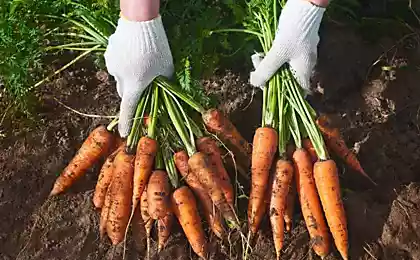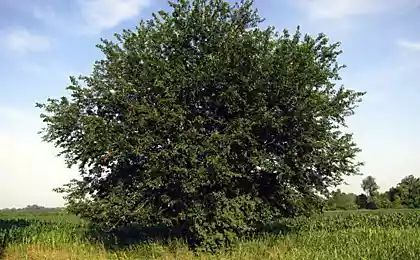301
When and how to collect carrots
Harvesting is the most troublesome, but in some ways the most pleasant time for a gardener. For the most part, the final chords at the end of the season sound in autumn. Although due to climate change, the timing of harvesting many vegetables is somewhat shifted, the general rules are still relevant today. Each vegetable has its own harvesting period.
Since childhood, when I helped my grandmother with the harvesting of vegetables, I firmly remember that winter cabbage should be tempered by the first small autumn frost (-1-3 ° C). But carrot harvesting begins long before the cabbage marathon, immediately after potato harvesting, and usually falls on the second week of September.
At the time, I didn’t understand why sometimes untested new varieties of carrots didn’t survive the winter, sometimes even half of the root crops didn’t live to see it.
There are several reasons for this:
1. Different timing of carrot ripening
2. Untimely collection of carrots
3. Violation of carrot storage technology
4. Weather conditions
Now let’s figure out when to remove the carrots. Some gardeners sow carrots in the winter or use varieties with an early ripening period so that young sweet carrots can be harvested in the middle of summer. Such carrots are usually unsuitable for long storage. If you miss the harvesting period of early carrots, often it cracks in the ground, loses all its juiciness and, as a result, loses taste. I used to sow early carrots to make carrots. Such carrots are desirable to collect when its diameter reaches 1 cm. It makes beautiful vitamin baby soups and salads. Carrots of medium maturity should be grown for 80-110 days. Also about its maturity can speak yellowed lower leaves. You should not overtake carrots in the soil, otherwise the flesh will be loose and the taste will deteriorate.
It is also a mistake to believe that the top should be all yellow and sluggish. This is a sign of a sick root crop, but not its maturity.
Carrots of late ripening (more than 110 days), otherwise - autumn carrots. It gathers in autumn in the first 2 weeks of September, but with an eye to weather conditions - the day should not be rainy.
Increasingly, I hear from the same gardeners, amateurs, that you need to leave carrots to the first small subzero temperature. But I strongly disagree with this, having removed more than one hectare of carrots from my grandmother in the village. At sub-zero temperatures, carrots often begin to be affected by gray rot. As a result, crops can be lost during storage.
But you should not dig up carrots early. The temperature difference will also be unfavorable during storage. If the outside temperature is even more +20 ° C, you do not need to sharply move carrots to a cold cellar, wait until the air temperature becomes less and the carrots stop growing. Cooling for carrots is more desirable, since at this time it accumulates sugar. When the air temperature reaches +4 ° C, the carrots will stop growing. After setting good weather and low temperatures in September, feel free to get down to business.
How do you harvest carrots?
Having figured out the question of when exactly to start cleaning, it is important not to lose sight of exactly how to harvest the crop in order to get a good product during storage.
A month before picking carrots, we completely stopped watering it so as not to provoke growth or cracking.
To collect carrots, the grandmother chose a sunny, warm enough day, without waiting for the night frosts to begin. Digging carrots mainly with pitchforks. They pulled and pulled from the ground behind the top. Carefully lift the ground behind the top and clean the root crop from the ground with our hands.
I'm a proponent of digging carrots, not shoveling them out completely. If you just pull even short root crops without digging, and even in heavy soil, the top can remain in your hands, and the carrots in the ground. If you dig with a shovel, make sure that there is no damage to the root crop, the injured vegetable is poorly stored.
After the harvest is dug, trim the greens. I'm twisting the tray with my hands, which extends the shelf life. More than once I heard that you need to leave carrots on the ridge with the top to dry. But in fact, the bottom pulls nutrients from the root crop. My rabbit is more useful than a carrot. And you need to dry carrots for a short time, do not wait for the root crop to dry. Otherwise, the pulp will no longer have sufficient juiciness and leanness.
Now I intuitively know when to dig carrots. But at first, to test myself, I dig up a couple of root vegetables, examined and tried it.
How do you store carrots?
In my grandmother's cellar, carrots stood out as a concrete plot, fenced with boards. There were boards on the floor and wormwood on them. Wormwood, according to the grandmother, was supposed to play the role of a “frightener” for mice. I keep carrots in drawers, which until the moment of storage for more than one month was well dried in the sun.
Many of my acquaintances pour layers of carrots with a mixture of sand and lime-fluff (10:1).
Now that you know how I dig up carrots, you can prepare for the winter raw materials of the “highest sample”, and at the same time share what methods you like when cleaning carrots and how you then organize its high-quality storage.
Source: www.7dach.ru
Since childhood, when I helped my grandmother with the harvesting of vegetables, I firmly remember that winter cabbage should be tempered by the first small autumn frost (-1-3 ° C). But carrot harvesting begins long before the cabbage marathon, immediately after potato harvesting, and usually falls on the second week of September.
At the time, I didn’t understand why sometimes untested new varieties of carrots didn’t survive the winter, sometimes even half of the root crops didn’t live to see it.
There are several reasons for this:
1. Different timing of carrot ripening
2. Untimely collection of carrots
3. Violation of carrot storage technology
4. Weather conditions
Now let’s figure out when to remove the carrots. Some gardeners sow carrots in the winter or use varieties with an early ripening period so that young sweet carrots can be harvested in the middle of summer. Such carrots are usually unsuitable for long storage. If you miss the harvesting period of early carrots, often it cracks in the ground, loses all its juiciness and, as a result, loses taste. I used to sow early carrots to make carrots. Such carrots are desirable to collect when its diameter reaches 1 cm. It makes beautiful vitamin baby soups and salads. Carrots of medium maturity should be grown for 80-110 days. Also about its maturity can speak yellowed lower leaves. You should not overtake carrots in the soil, otherwise the flesh will be loose and the taste will deteriorate.
It is also a mistake to believe that the top should be all yellow and sluggish. This is a sign of a sick root crop, but not its maturity.
Carrots of late ripening (more than 110 days), otherwise - autumn carrots. It gathers in autumn in the first 2 weeks of September, but with an eye to weather conditions - the day should not be rainy.
Increasingly, I hear from the same gardeners, amateurs, that you need to leave carrots to the first small subzero temperature. But I strongly disagree with this, having removed more than one hectare of carrots from my grandmother in the village. At sub-zero temperatures, carrots often begin to be affected by gray rot. As a result, crops can be lost during storage.
But you should not dig up carrots early. The temperature difference will also be unfavorable during storage. If the outside temperature is even more +20 ° C, you do not need to sharply move carrots to a cold cellar, wait until the air temperature becomes less and the carrots stop growing. Cooling for carrots is more desirable, since at this time it accumulates sugar. When the air temperature reaches +4 ° C, the carrots will stop growing. After setting good weather and low temperatures in September, feel free to get down to business.
How do you harvest carrots?
Having figured out the question of when exactly to start cleaning, it is important not to lose sight of exactly how to harvest the crop in order to get a good product during storage.
A month before picking carrots, we completely stopped watering it so as not to provoke growth or cracking.
To collect carrots, the grandmother chose a sunny, warm enough day, without waiting for the night frosts to begin. Digging carrots mainly with pitchforks. They pulled and pulled from the ground behind the top. Carefully lift the ground behind the top and clean the root crop from the ground with our hands.
I'm a proponent of digging carrots, not shoveling them out completely. If you just pull even short root crops without digging, and even in heavy soil, the top can remain in your hands, and the carrots in the ground. If you dig with a shovel, make sure that there is no damage to the root crop, the injured vegetable is poorly stored.
After the harvest is dug, trim the greens. I'm twisting the tray with my hands, which extends the shelf life. More than once I heard that you need to leave carrots on the ridge with the top to dry. But in fact, the bottom pulls nutrients from the root crop. My rabbit is more useful than a carrot. And you need to dry carrots for a short time, do not wait for the root crop to dry. Otherwise, the pulp will no longer have sufficient juiciness and leanness.
Now I intuitively know when to dig carrots. But at first, to test myself, I dig up a couple of root vegetables, examined and tried it.
How do you store carrots?
In my grandmother's cellar, carrots stood out as a concrete plot, fenced with boards. There were boards on the floor and wormwood on them. Wormwood, according to the grandmother, was supposed to play the role of a “frightener” for mice. I keep carrots in drawers, which until the moment of storage for more than one month was well dried in the sun.
Many of my acquaintances pour layers of carrots with a mixture of sand and lime-fluff (10:1).
Now that you know how I dig up carrots, you can prepare for the winter raw materials of the “highest sample”, and at the same time share what methods you like when cleaning carrots and how you then organize its high-quality storage.
Source: www.7dach.ru





















